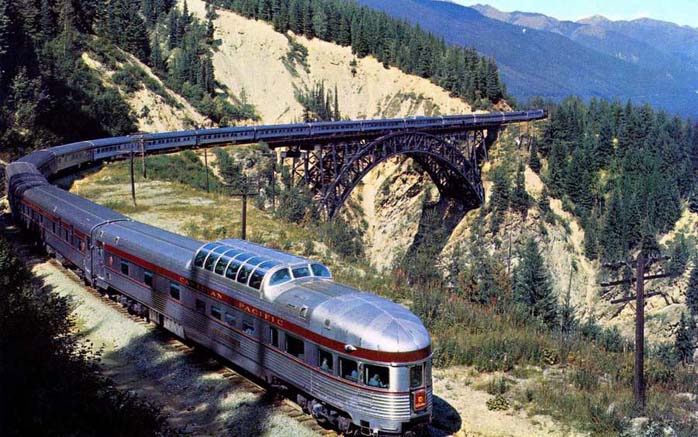
Number 15
Nov. 22, 1978
Ushered in by Streamliner

Amid the pageantry and the fanfare a new chapter in Canadian railway history was being written.
It was a paradox no one could have foreseen on that day 23-years-ago when The Canadian, shimmering in its polished stainless steel coat, rolled smoothly out of Windsor Station in Montreal for its inaugural run across the country.
As the streamliner on 24 Apr 1955 ushered in a new era for Canadian Pacific and "a revolution in Canadian rail passenger travel" for the public, on 28 Oct 1978 it signalled yet another "revolution", the beginning of the consolidation of all rail passenger services in Canada under VIA, and the end of an era for Canadian Pacific.
The Canadian came on the scene during the post-war economic boom when lifestyles, and styles, were changing quickly. The railway was no exception. This excerpt from a 1954 press release told the story of the latest vogue in rail passenger services, "Canada's iron-horse-age passenger coaches are being converted into rolling resort hotels, minus the swimming pool, in a major face-lifting that's putting millions of dollars worth of glamour onto Canadian tracks."
It was glamour on the outside, scenic dome cars, a travelling art exhibit in the mural lounge, observation sections, and under all those attractions, as never before seen on Canadian rails, some formidable advances in technology that made it all work.
Swing hangers were specially designed to bolster suspension, providing a smoother ride by reducing the car body roll and improving safety.
The tight-lock coupler, the Standard H Type, was introduced to Canada. It eliminated slack in the coupler contour, which minimized jerks and vibration between cars, also cutting out noise caused by slack.
Draft gears were introduced for sound-deadening, and the trains were outfitted with CF type disc brakes, invented by the manufacturer of The Canadian's 173 passenger coaches, the Budd Company of Philadelphia.
But in the public's eye, The Canadian was, as then company Vice-president N.R. Crump said, "An entirely new concept of railway travel."
Among the attractions of this new concept:
● Designed to add to the relaxing atmosphere of The Canadian was a hidden speaker public address system, the first of its kind to be used aboard a train in Canada. The system offered soft music and was used for commentary on Canada's countryside.
● Tail-piece of the trains was their most spectacular characteristic, a 24-seat, upper level dome, enclosed in heat-resistant, glare-proof glass giving passengers full, 360 degree vision. Forward end of the dome car were three double bedrooms and a drawing room with a passageway leading under the dome and past a glass-enclosed beverage room. Each of these lounges featured an original portrait of a provincial park by a renowned Canadian painter, the 18 murals forming a permanent, travelling art exhibit.
● Past the mural lounge, behind the raised dome, lay a streamlined observation section and a curved staircase leading to the dome.
● Gyralites, mounted on the leading diesel unit of each train directed white beams skyward continuously from dusk to dawn in an oscillating pattern resembling a figure 8.
● Plastic interior wall lining was the latest in design. It made cleaning easy, and eliminated the necessity of periodic repairs.
It was luxury fit for a king, or as circumstance would have it, a queen. The royal family has on numerous occasions taken in the Canadian countryside aboard the streamliner.
Tours of Canada over the rails by the British monarchy date back to Queen Elizabeth II's grandparents, but few have ridden in the luxury afforded the reigning monarchy aboard The Canadian. Indeed, during a 1901 tour by the Duke and Duchess of York (later to be King George V and Queen Mary) a picture taking session had the royal party perched above the cow catcher on the front of the locomotive.
The Canadian had become an institution in Canada, a status it earned almost as it rolled off the assembly line. As one veteran reporter wrote in 1955 as he viewed the train during its inaugural run, "Still only a few hours old, The Canadian is already an institution. This train has elegance. It has beauty. It has an air..."

